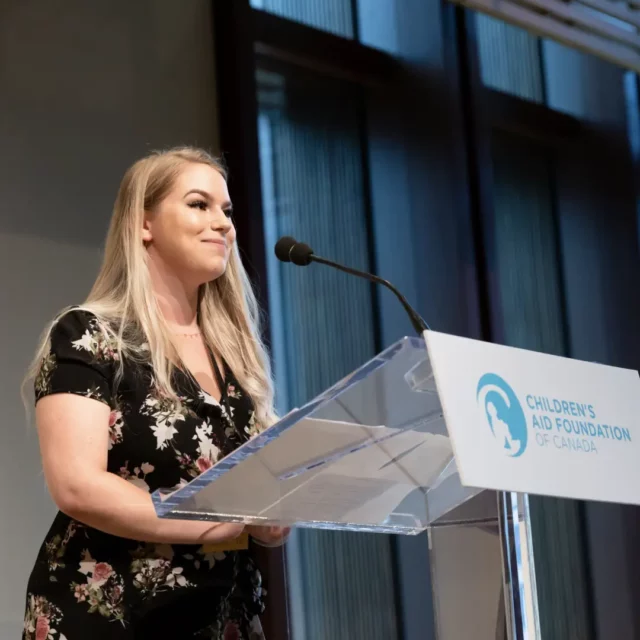Entering adulthood seems harder than ever these days. The journey to independence and autonomy just takes longer, and the faltering economy and COVID-19 pandemic have made the way forward even more difficult. As a result, many young people have chosen to remain at home with their parents, so that when they do leap, they have the finances, education, and skills they need to succeed.
For young people transitioning out of the child welfare system at 18 or 19, adulthood is even more precarious. While a couple of provinces have announced that they will establish programs that provide more support until youth are in their mid-20s, there are approximately 2,300 young people who “age out” of government care each year in Canada, lacking the comfort of a familial safety net. Pushed out of foster or group homes, they no longer qualify for support from the child welfare system. Out in the world, without family support, education, or stable employment they are confronted with a tsunami of obstacles.
Why youth enter care
Child protection services remove children and youth from their homes for several reasons: substance use, mental health issues, violence, or sexual abuse are just a few on a long list which also includes poverty, racism, and ableism. Entering the system turns a child’s life upside down. The grief, uncertainty, and pain that most experience often leave them with trauma.
Upon entering government care, these kids are expected to quickly adapt to a new family, school, and community. Most will do this more than once. By 17, the average youth in care has experienced five placement school changes. Uprooted time and time again, young people in care struggle to keep up with schoolwork. In fact, less than 50% will be able to complete high school.
And then, after so much childhood adversity, they “age out” of the system.
Out on their own
Left with no choice, young people leaving care are left to venture out on their own. Without a steady income or financial support, some find it hard to secure stable housing. They may find themselves couch surfing or experiencing homelessness. According to a Canadian study of youth homelessness, 58% of youth who are homeless reported some type of involvement with child protection services in their lifetime. And, youth leaving care are nearly 200 times more likely to experience homelessness compared to their peers.
Kids who experience the childcare system are resilient and mature beyond their years, made so through the art of survival, not necessarily choice. Struggling with childhood trauma and working hard to make ends meet, too many young people in transition leave the care of the child welfare system unable to find the stability they need to build successful, fulfilling lives.
Youth leaving care deserve to be seen and supported
Young people with lived experience of government care share the same aspirations as their peers: They wish to live a life on their own terms. They want to build happy, healthy relationships, they want to find work that is satisfying. To achieve this, they need access to more resources than are currently available.
According to a recent Ipsos survey commissioned by Children’s Aid Foundation of Canada which informed our Focus on Youth report, half of Canadians with an eldest child between the ages of 18 – 29, still live at home. And only 1 in 3 Canadians believe that 18-year-olds have the necessary skills and financial resources to live away from home and support themselves independently.
Children’s Aid Foundation of Canada funds several programs that help youth in transition gain the skills, networks and resources they need to move beyond just surviving:
- Programs like Homebase help young people pay first and last month’s rent or furnish their home.
- The Connections Program connects new youth in transition to mental health support. The program is accessible to youth between the ages of 18 and 29 who are transitioning or have already transitioned from care and live in Greater Toronto.
- The Ambassador Program provides youth who have left care with an opportunity to complete their high school diploma, in a supportive and nurturing environment that reflects and respects their lived experiences and connects them to role models and mentors.
- Our Post-Secondary Education Program provides hundreds of scholarships and bursaries to young people who have left care. They are creating a powerful legacy, with many continuing their education to find rewarding careers in everything from social work and advocacy to education.
The largest barrier for youth from care is lack of financial support. When you age out at 18, you can barely afford housing or food, and post-secondary education can fall into the background… At times, the thought of having student debt or having to fit a work schedule around classes was worrying and I wondered whether I would be able to attend school while having all of these adult responsibilities. – Tawnya, first voice advocate and former youth in care
Children’s Aid Foundation of Canada can support these programs because of our generous network of donors, but we know we can do much, much more. Together, as a network of compassionate and committed donors, partners, and fundraisers, let’s help provide these (far too) young people leaving care with what they need to thrive.




